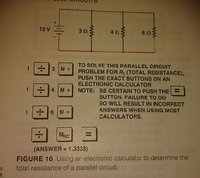I think you are saying that you don't have a calculator with an MRC button. According to one site I found, MRC means memory-recall-and-clear; when you press it once, it recalls the number in memory, and if you press it two times in a row, it clears memory. Calculators I'm familiar with that have these memory keys just have separate MR and MC. (The Windows calculator accessory is an example.) You just need MR here. But there's more going on.
Here's what the procedure is supposed to do, with the missing 1 inserted in the last line, and assuming the memory has been cleared first. (Without the 1 before the last division, no calculator would get their answer, I'm sure; and without clearing memory, all bets are off.)
1 ÷ 3 M+ : divides 1 by 3, put result 0.33333333 into memory
1 ÷ 4 M+: divides 1 by 4, add result 0.25 to memory, changing it to 0.58333333
1 ÷ 6 M+: divides 1 by 6, add result 0.16666667 into memory, changing it to 0.75
1 ÷ MR = : recalls 0.75 from memory, divides 1 by 0.75, displaying 1.33333333
But I did not get this result when I do it on the Windows calculator in standard mode, using MR for MRC. Instead, I get 1/13 = 0.0769230769230769.
That is because this calculator's M+ adds whatever is in the
display to memory, so the memory just contained 3+4+6 = 13.
To get what they expect, I have to tell it to evaluate before each M+:
1 ÷ 3 = M+ : divides 1 by 3, add result 0.33333333 to memory
1 ÷ 4 = M+: divides 1 by 4, add result 0.25 to memory, changing it to 0.58333333
1 ÷ 6 = M+: divides 1 by 6, add result 0.16666667 into memory, changing it to 0.75
1 ÷ MR = : recalls 0.75 from memory, divides 1 by 0.75, displaying 1.33333333
You're right that this sort of calculation depends heavily on the particular calculator used, and it was foolish of that author to assume that everyone's calculator is identical. There is no standard.

